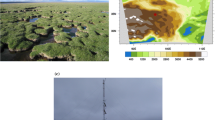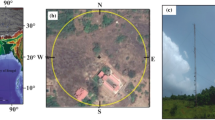Abstract
The turbulence spectra and energy budget were investigated based on eddy covariance method over an open-water highland lake (Erhai Lake) in Southwest China. We estimated the annual total evaporation and CO2 emission from the lake, and the evaporation trend in the past few decades was also discussed. Due to the large thermal inertia of lake water, the surface water temperature lagged behind the air temperature. Maximum lake-air temperature difference of about 4 °C had been observed in November. Water temperature profile measurements revealed that the stratification of lake water was not evident throughout the year. The spectra and cospectra of wind speed and temperature roughly satisfied the −2/3 and −4/3 rule in inertial subrange, respectively. The w spectra were observed to have a larger contribution from higher frequencies than other variables. Obvious shifts of spectra and cospectra peaks toward higher frequencies were observed as the atmospheric stratification became more stable. The lake acted as a heat sink from March through June and quickly released heat into the atmosphere from September through December. Average energy balance closure for the lake was about 80 % in 2012. The lake majorly acted as a source of CO2 to the atmosphere, but weak sinks of CO2 were observed in the summer and early fall. The total annual emission of CO2 was estimated to be 333.28 g C m−2 year−1. The annual evaporation over the lake decreased due to the increased amount of low cloud and precipitation, with the lower annual evaporation in the 1990s compared to that in the 1980s.













Similar content being viewed by others
References
Adrian R, Reilly CMO, Zagarese H, Baines SB, Hessen DO, Keller W, Livingstone DM, Sommaruga R, Straile D, Donk EV, Weyhenmeyer GA, Winder M (2009) Lakes as sentinels of climate change. Limnol Oceanogr 54(6):2283–2297
Assouline S, Tyler SW, Tanny J, Cohen S, Bou-Zeid E, Parlange MB, Katul GG (2008) Evaporation from three water bodies of different sizes and climates: measurements and scaling analysis. Adv Water Resour 31(1):160–172
Barros N, Cole JJ, Tranvik LJ, Prairie YT, Bastviken D, Huszar VLM, Giorgio PD, Roland F (2011) Carbon emission from hydroelectric reservoirs linked to reservoir age and latitude. Nat Geosci 4:593–596
Bates GT, Giorgi F, Hostetler SW (1993) Toward the simulation of the effects of the Great Lakes on regional climate. Mon weather rev 121(5):1373–1387
Blanken PD, Rouse WR, Culf AD, Spence C, Boudreau LD, Jasper JN, Kochtubajda B, Schertzer WM, Marsh P, Verseghy D (2000) Eddy covariance measurements of evaporation from Great Slave Lake, Northwest Territories, Canada. Water Resour Res 36(4):1069–1077
Downing JA, Prairie YT, Cole JJ, Duarte CM, Tranvik LJ, Striegl RG, McDowell WH, Kortelainen P, Caraco NF, Melack JM, Middelburg JJ (2006) The global abundance and size distribution of lakes, ponds, and impoundments. Limnol Oceanogr 51(5):2388–2397
Duarte CM, Prairie YT, Montes C, Cole JJ, Striegl R, Melack J, Downing JA (2008) CO2 emissions from saline lakes: a global estimate of a surprisingly large flux. J Geophys Res Biogeosci 113(G04041). doi:10.1029/2007JG000637
Dutra E, Stepanenko VM, Balsamo G, Viterbo P, Miranda PMA, Mironov D, Schär C (2010) An offline study of the impact of lakes on the performance of the ECMWF surface scheme. Boreal Environ Res 15(2):100–112
Huang HJ, Wang YP, Li QH (2010) Evaporation variation from Erhai Lake and its controls under climatic warming (in Chinese). J Meteorol Environ 26(1):32–35
Kormann R, Meixner FX (2001) An analytical footprint model for non-neutral stratification. Bound-Layer Meteorol 99(2):207–224
Kortelainen P, Rantakari M, Huttunen JT, Mattsson T, Alm J, Juutinen S, Larmola T, Silvola J, Martikainen PJ (2006) Sediment respiration and lake trophic state are important predictors of large CO2 evasion from small boreal lakes. Glob Chang Biol 12(8):1554–1567
Li MS, Ma YM, Sun FL, Zhao YZ, Wang YJ, Lv YQ (2008) Characteristics of micrometeorology and exchange of surface energy in the Namco region (in Chinese). Plateau Meteorol 27(4):727–732
Li ZG, Lv SH, Ao YH, Wang SY (2012) Analysis of micrometeorology and CO2 flux characteristics over Lake Ngoring lakeside region in summer (in Chinese). Prog Geogr 31(5):602–608
Liu HZ, Feng JW, Sun JH, Wang L, Xu AL (2014) Eddy covariance measurements of water vapor and CO2 fluxes above the Erhai Lake. Sci China Earth Sci. doi:10.1007/s11430-014-4828-1
Ma R, Duan H, Hu C, Feng XZ, Li AN, Ju WM, Jiang JH, Yang GS (2010) A half-century of changes in China’s lakes: global warming or human influence?. Geophys Res Lett 37(L24106). doi: 10.1029/2010GL045514
Marotta H, Duarte CM, Sobek S, Enrich-Prast A (2009) Large CO2 disequilibria in tropical lakes. Glob Biogeochem Cycle 23(GB4022). doi: 10.1029/2008GB003434
Mauder M, Foken T (2006) Impact of post-field data processing on eddy covariance flux estimates and energy balance closure. Meteorol Z 15:597–609
Moncrieff JB, Massheder JM, Bruin HD, Elbers J, Friborg T, Heusinkveld B, Kabat P, Scott S, Soegaard H, Verhoef A (1997) A system to measure surface fluxes of momentum, sensible heat, water vapor and carbon dioxide. J Hydrol 188–189:589–611
Nordbo A, Launiainen S, Mammarella I, Leppäranta M, Huotari J, Ojala A, Vesala T (2011) Long-term energy flux measurements and energy balance over a small boreal lake using eddy covariance technique. J Geophys Res Atmos 116(D02119). doi: 10.1029/2010JD014542
Oswald CJ, Rouse WR (2004) Thermal characteristics and energy balance of various-size Canadian shield lakes in the Mackenzie River basin. J Hydrometeorol 5(1):129–144
Pacheco FS, Roland F, Downing JA (2013) Eutrophication reverses whole-lake carbon budgets. Inland Waters 4(1):41–48
Raymond PA, Hartmann J, Lauerwald R, Sobek S, McDonald C, Hoover M, Butman D, Striegl R, Mayorga E, Humborg C, Kortelainen P, Dürr H, Meybeck M, Ciais P, Guth P (2013) Global carbon dioxide emissions from inland waters. Nature 503(7476):355–359
Rouse WR, Oswald CM, Binyamin J, Blanken PD, Schertzer WM, Spence C (2003) Interannual and seasonal variability of the surface energy balance and temperature of central Great Slave Lake. J Hydrometeorol 4(4):720–730
Rouse WR, Blanken PD, Bussières N, Oswald CJ, Schertzer WM, Spence C, Walker AE (2008) An investigation of the thermal and energy balance regimes of Great Slave and Great Bear lakes. J Hydrometeorol 9(6):1318–1333
Schertzer WM (1997) Freshwater lakes. In: The surface climates of Canada. McGill-Queens University Press. pp 124-148
Schindler D (2009) Lakes as sentinels and integrators for the effects of climate change on watersheds, airsheds, and landscapes. Limnol Oceanogr 54(6):2349–2358
Spence C, Rouse WR, Worth D, Oswald C (2003) Energy budget processes of a small northern lake. J Hydrometeorol 4(4):694–701
Vesala T, Eugster W, and Ojala A (2012) Eddy covariance measurements over lakes. In: Eddy covariance: a practical guide to measurement and data analysis. Springer Dordrecht Heidelberg, London. 438 pp
Wang Z, Wang YC, Hu MM, Li Y, Liu YD, Shen YW, Li GB, Wang GH (2011) Succession of the phytoplankton community in response to environmental factors in north lake Erhai during 2009–2010. Fresenius Environ Bull 20(9):2221–2231
Xiao W, Liu SD, Li XH, Wang W, Hu N, Jiang X, Li YX, Xu XH, Zhang XS (2012) Transfer coefficients of momentum, heat and water vapour in the atmospheric surface layer of a large shallow freshwater lake: a case study of Lake Taihu (in Chinese). J Lake Sci 24(6):932–942
Xu XD, Zhang RH, Shi XH, Lu CG, Shi XH, Zhang SJ, Bian LG, Cheng XH, Li P, Ding GA (2008) A new integrated observational system over the Tibetan Plateau. Bull Am Meteorol Soc 89(10):1492–1496
Wilson K, Goldstein A, Falge E, Aubinet M, Baldocchi D, Berbigier P, Bernhofer C, Ceulemans R, Dolman H, Field C, Grelle A, Ibrom A, Law BE, Kowalski A, Meyers T, Moncrieff J, Monson R, Oechel W, Tenhunen J, Valentini R, Verma S (2002) Energy balance closure at FLUXNET sites. Agric For Meteorol 113(1):223–243
Zhang RH, Koike T, Xu XD, Ma YM, Yang K (2012) A China-Japan cooperative JICA atmospheric observing network over the Tibetan Plateau (JICA/Tibet Project): an overviews. J Meteorol Soc Jpn 90C:1–16
Acknowledgments
This work was supported by the National Natural Science Foundation of China (Grant Nos. 41030106 and 41021004) and CMA key project (GYHY201406001). We thank the staffs from the Yunnan Provincial Institute of Meteorology and Dali National Climatic Observatory for their helps to maintain the measurement and provide historical data.
Author information
Authors and Affiliations
Corresponding author
Rights and permissions
About this article
Cite this article
Feng, J.W., Liu, H.Z., Sun, J.H. et al. The surface energy budget and interannual variation of the annual total evaporation over a highland lake in Southwest China. Theor Appl Climatol 126, 303–312 (2016). https://doi.org/10.1007/s00704-015-1585-9
Received:
Accepted:
Published:
Issue Date:
DOI: https://doi.org/10.1007/s00704-015-1585-9




